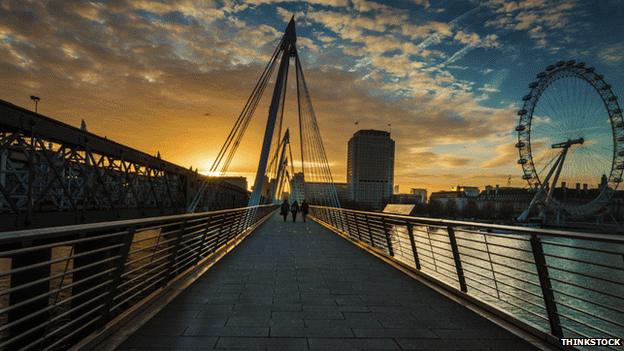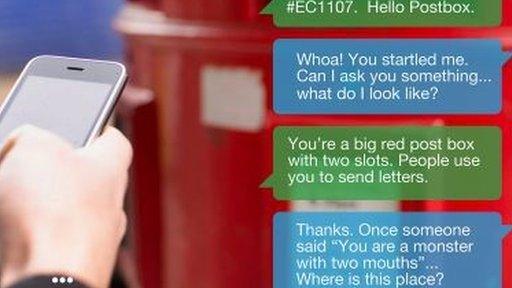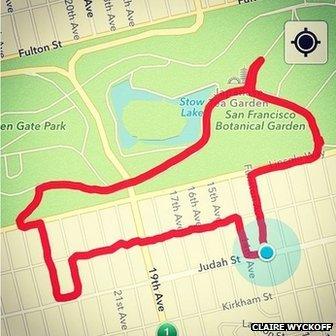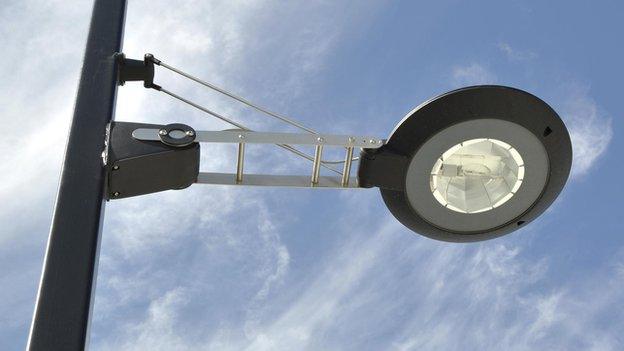Maps, apps and technology to make city life more fun
- Published
Jane Wakefield tests out the headgear
Life in cities can be hectic and stressful - but some technology designers are going out of their way to make them more fun.
I'm walking down Oxford Street in central London with a helmet on my head. I feel more than a little silly; the looks I'm attracting could be adding to my stress levels, which are being measured by the hat.
The helmet is measuring my frustration and excitement levels to assess how I react while navigating the city.
Perhaps unsurprisingly I'm calmer on the back streets, walking through a beautiful mews, a cobbled alleyway and a park, than in the hustle and bustle.
The helmet is the brainchild of PhD student Panos Mavros, from University College London's Bartlett Centre for Advanced Spatial Analysis (Casa).
"The idea is to use techniques from neuroscience and computer science to better understand how people perceive cities," he says.
"It taps into someone's excitement and arousal so, for example, a nicely designed shopfront may grab the wearer's attention."

Do people want technology to find the quickest route or the most scenic?
While such data could have huge value to shop owners looking to design the best windows, this project is not designed for that purpose.
Mr Mavros is working with the Guide Dogs for the Blind Association to try to establish which routes are the least stressful for those whose vision is impaired.
Technology is not known for its empathy. GPS navigation apps may have revolutionised our navigation methods but most seek the quickest - rather than nicest - journey.
That may be about to change, however, as researchers at Yahoo work on an algorithm searching for the most scenic ways across urban landscapes.
Using London as an example they are "crowd-sourcing" opinions about the beauty, quietness and happiness of different streets, and using these to plot the most pleasant route on a graph.
When the project is extended to other cities, the researchers plan to extract metadata from photos posted on the Flickr website.
The eventual aim is to design a mobile app that offers people "happy routes" around lots of cities.
The app represents an acknowledgement that people want a bit more humanity in their technology.

Will chatting to postboxes be common in future?
Humanising technology is very much at the forefront of Dr Andrew Hudson-Smith's mind. As director of Casa and member of the Smart London board he has designed a lot of technology aimed at making city life better - and a bit more fun.
Interactive maps of the Casa campus and a pigeon simulator that lets people "fly" around London are among several projects he is happy to admit "don't really have a point".
His latest project will see users "jumping" on a virtual rollercoaster that wraps itself around the Shard skyscraper and travel across a 3D model of the city.
And a version will be created for early adopters of the Oculus Rift virtual reality headset.
Riding an urban rollercoaster in VR
'Childhood fantasies'
This is all part of "gamification", a phenomenon describing the use of gaming techniques in unusual contexts such as work, school or cities.
Another London firm, Pan Studios, is developing Run an Empire - a game that aims to fuse the real and the digital and turn local neighbourhoods into arenas for play.
Players can capture and maintain control of local areas by walking or jogging around them. The higher the number of trips, the more secure they make each place against invasion.
"The game tests the thesis about applying computer-game logic to the real world," says developer Ben Barker.
It recalls childhood fantasies of the whole world being a playground, he adds.
"I, like others, grew up playing, inventing, imagining and running around fields or parks or even sneaking into places I shouldn't be," he said.
"But in cities, the assumption is that spaces are owned by others and play is not something that we have permission to do."
Mr Barker has long been interested in the idea of making public space more fun, partly in reaction to the use of sensors and data to make cities more efficient.
His project Hello Lamp Post ran last year as part of Bristol's "smart city" plans.
Via their smartphones, citizens could have "conversations" with postboxes, lamp posts, bins and bollards, and listen to those of others.

Runner Claire Wyckoff plots pictures with her runs.
It took time to convince people of the project's benefit and value, Mr Barker says.
But gradually they "interacted with it, talked about it on social media and recommended it to others", he says. "It started to help define the city."
Eventually 20,000 people took part in the project and a similar one will be launched soon in Austin, Texas.
People are increasingly finding ways to make the data trails they leave around cities more fun.
San Francisco runner Claire Wyckoff manipulates the data in her Nike+ fitness app.
Recently she has taken up what she calls "draw running", planning her routes with GPS to form pictures of, among other things, dogs and faces.
"I hope people run with it, and this changes how people use Nike+. That's where this gets really cool to me. People hacking brands," she told Vogue magazine.
In a world increasingly run by data and algorithms, people seem determined to ensure the basic principles of humanity are not lost - and fun is injected into city life.
Having a laugh is as important a part of urban living as the trains running on time and those planning our future cities would do well to remember that.
- Published2 October 2014

- Published25 September 2014

- Published18 September 2014
